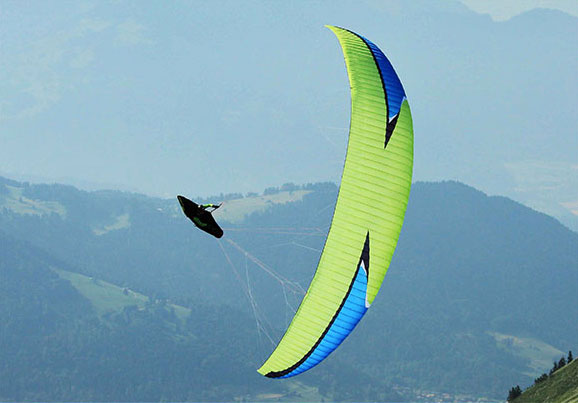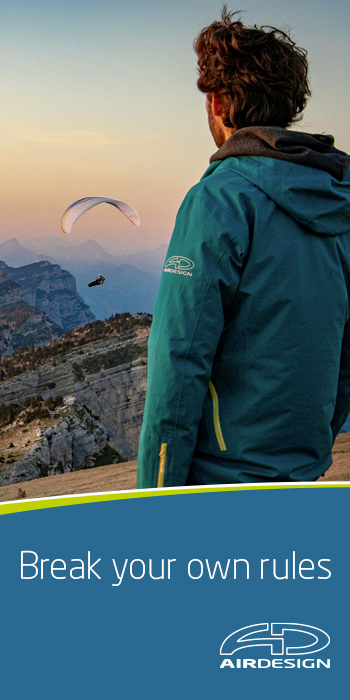
NIVIUK Peak 4 tested and tried – Indifference is an impossibility
Ziad Bassil has been flying paragliders for over 20 years. He flies the mountains of his native Lebanon and provides the paragliding community with independent and unbiased glider reviews on the latest product releases. His opinions and comparisons can be found on his blog : Dust of the Universe.

NIVIUK Peak 4
The long-awaited replacement of the EN-D Peak 3 has at last arrived.
I flew the Peak 4 over a period of several good days and in some variable conditions, flying the Peak 4-23 (PTV 85-105kg) at 98kg all-up, and making comparisons the Mantra MS, the Avax XC 5-26, the IP6-23, the Peak 3, the Triton 2-S, UP Trango XC3.
Launching the P4-23 is easier than the IP6, a little more complex than the M6, XC5, UP Trango XC3, but all-in-all fairly routine EN-D behaviour. It doesn’t have the forward pitch tendency of the IP6, and any EN-D pilot would find it quite manageable in light or strong breezes.
TURN ABILITY
I guess this is one of the key characteristics in a glider for me.
Immediately after take off, first turn and first smile…The P4 has light to moderate brake pressure, and reacts after the first 15cm of slack with a super wonderful agility! This high aspect ratio glider can be turned very tightly and in a very small radius without the dive. Only 15 cm after the slack are needed to steer the glider gracefully. The feeling and authority on the brakes even in turbulent cores are impressive; I have never as yet flown a glider with a 7 aspect ratio that can turn like a 5.5! The P4 is more agile than the M6, the Triton 2, the Trango XC3, and relatively similar to the XC5.
CLIMB RATE
We flew this glider in some very weak to strong, windy conditions as well as moderate to slightly turbulent leeside conditions, enabling us to get a more global picture of its capabilities.
In very weak conditions (less than 0.5 m/s) where some pilots would not have much ability to stay in the air, the IP6-23 flown at 98kg all up would float nicely and communicated those tiny bits of lift to the pilot showing him the way to turn. In these weak conditions the P4-23 at 98kg all-up does not give this information to the pilot and after several attempts where the IP6 could exploit those light lifts and gain some altitude, the P4 hovers much the same. Once the lift gets above 0.7 m/s the P4 will gracefully climb and can easily match the IP6-23 climb rate. In stronger thermals I believe the P4 would have a slight advantage over the IP6, due to the superb brake authority.
This is surely very picky from a personal point of view and I could not say that the P4 is the “floatier” glider, but to give you an idea, wings with similar efficiency would be: the Gin GTO-2 S @ 9kg3 or the Avax XC5-26 @ 92kg. The M6 MS @ 95kg is slightly more efficient in the very weak lift as is the Artik 4-25 flown @ 90kg. The P4-23 @ 98kg will out climb the M6 MS in more windy and difficult conditions showing the P4’s ability to surf the air efficiently without pitching.

GLIDE AND SPEED
After several glides at trim, half bar and full speed, the P4-23 @ 98kg showed a similar glide ratio as a IP6-23 @ 98 with a fresh new line set. It is possible that the IP6-23 may have an insignificant advantage on glide at full speed, however this may be because in turbulent air the IP6 -23 felt more loaded and solid on the bar. The leading edge on the P4-23 on full bar is solid but not as much so as the IP6. The B-risers are slightly more pressured in order to feel the glider in the air, but I really liked those new black rubber grips!
Comparing to the P4-23 @ 98kg and the M6 MS @ 95kg, the trim speed is the same but full speed is slightly greater on the P4, and the overall gliding performance is also slightly better with the P4.
I tried to induce big ears however had to pull my arms up very far because of the split lines. At first it looks like I’m pulling the stabile lines because the ears have lots of pressure. They finally fold after pulling approx.. ±1m of lines, and pushing on the bar, but I don’t think they are very effective. Releasing the ears the reopening is very fast and quick and no line was stuck in the tips, unlike the M6 that had a tendency to cravat easily.
COMFORT AND USABILITY
I’ll be more specific in comparing gliders with similar aspect ratios:
I found that the Peak 4-23 relatively comfortable for an aspect ratio of 7, and it’s similar to the M6 in terms of comfort and behaviour.
I felt a neutral pitch in similar air where the M6 would pitch back when entering thermals. It has also the same comfort found on the Avax XC-5 and may be less hard work than the Trango XC-3 SM, whereas the Peak 4 felt more “block” solid and coherent in it’s structure.
360’s and wingovers are a delight. It’s really an agile glider!
CONCLUSION
Beautiful handling and brake authority for the Niviuk Peak 4, with top gliding performance, comfort and accessibility for this EN-D glider. The only thing I missed was the identical ability the IP6 had to thermal in very weak lift, but I’m sure that the Peak 4 will surely win many hearts. It is impossible to be indifferent.
Find out more on the Peak 4 here
In partnership with the Author, Rock the Outdoor has been authorised to modify the original text for reader appreciation.


